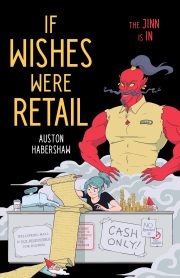1997: The State of Publishing
by Eleanor Wood
It has become a tradition at these annual meetings for SFWA’s agent to speak on “the state of publishing.” Publishing is in an intense state of flux–which means no one has a clear handle on how to best publish books, what distribution will be like in two years, or what unexpected corporate shifts and mergers will transpire.
Most of you have probably heard how slow the market is, about cutbacks in the number of science fiction and fantasy titles per month. Some may have been affected by the skittishness of editorial heads and marketing people if the returns on your latest book were unusually high. Bookstore chains cut back on initial orders–Waldenbooks, which used to make initial orders based on an estimated eight weeks of sale, has shaved that to three!
Some of you may know the Safeway story–how one large Seattle based customer triggered a desperate free-for-all which decimated the number of independent companies that distribute books to non bookstore outlets such as drug stores, supermarkets, etc. (the so-called ID sales). Stated briefly, Safeway announced it would no longer do business with its numerous book wholesalers–only one distributor would now handle its book business. This meant breaking the “exclusive territory” franchises distributors had respected. The rules were broken, and other major accounts soon followed suit, some selling their book rack space to the highest bidder. Smaller companies were forced out, and one publisher told me that whereas there were 350 ID distribution companies in 1995, now there are less than 70. That means, for the moment, publishers can’t count on the level of ID sales they had in the past, and so print runs for most paperbacks are now smaller.
Between the ID disaster and merger mania, which after more than 15 years shows no sign of abatement, it’s no wonder that authors–and agents–look at “the state of publishing” with some degree of trepidation.
Despite the upheavals, I take an optimistic view and see present and near-future changes that are both exciting and profitable.
First, let’s look at some encouraging statistics: total sales of books in this country are up. From 1990 to 1995 total book sales rose 32%, from $19.04 billion in 1990 to $25.04 billion in 1995. Bookstore sales rose 4.1% in 1996 to $10.69 billion, according to the U.S. Census Bureau. Barnes & Noble and Borders have reported substantial increases in net income for 1997. This sales increase is led by its superstores, where sales have risen 38%. Borders gave a 12% gain in earnings in ’97. According to Publishers Weekly, this increase is due to the superstore division.
Superstores are opening at a fantastic rate. Barnes & Noble plans to open 90 each year. Borders is opening about 40 annually. According to a Prudential Securities analyst quoted in The Wall Street Journal, this growth should continue at least through the year 2000, and the U.S. can support at least 1500 such superstores. And while Barnes & Noble and Borders are engaged in turf wars, both chains are profiting from what one journalist described as America’s “surging appetite for books.”
It’s true some small independent bookstores have suffered, and the chains, starting in 1994, now account for over half of publishers’ bookstore business. But one reason for the superstores’ success can be traced to growing changes in the nature of book buying. Bookshopping for many is no longer a dry transaction of finding the book you want on the shelves, paying for it and leaving. An increasing number of stores have made buying books part of a larger social experience–a pleasant place for browsing, for stopping with a friend for coffee and enjoying a delightful cafe atmosphere. Many stores feature book-related events which amount to evening socials. A recent article on Long Island and dating–called “Your Bookstore or Mine?”–is indicative of this rising trend.
It is, actually, a return to one of the earliest forms of commerce for books–the circulating libraries of 18th century England, where people paid a fee to rent out a book. These circulating libraries also sold small items such as trinkets, lottery tickets and so forth, and people came to them as a means of social interchange–in our parlance, to “hang out.” In fact, these places grew to be such fountains of local gossip that English playwright William Sheridan remarked, “A circulating library in a town/Is an evergreen tree of diabolical knowledge.”
To my way of thinking, this is all to the good, when book buying becomes part of America’s social fabric.
Technological advancements are helping to keep books alive–or at least to enjoy a longer shelf life. A publisher at Avon mentioned how it is now easier to go back to press on a book: whereas before it took at least 2-3 weeks and small reprint numbers were costly, the turn-around now can be as little as 4 days and, at least for the smaller printings, less expensive. Another science fiction publisher acknowledged his reorder numbers were up. Clearly he can benefit from such advances, as can those publishers who have successfully reissued classics in trade paperback and are introducing a whole new generation of readers to works by writers such as Alfred Bester, H.P. Lovecraft and Philip K. Dick.
Another very encouraging sign is the way companies are using computer technologies to track inventory in a cooperative manner. An executive at Ballantine Books explained their cooperative venture with the huge distributor/supplier Ingram. Each day the computers track stock, so that if the copies in stock on a book go down at one of the Ingram warehouses, the information is immediately and automatically relayed to the Random House warehouse, and the order to fill the stock will take place right away–no long waits for the publisher’s salesmen to get around to checking on a title. Effective cooperation with linked computers is fairly new, but as publisher/supplier partnerships grow, our country’s distribution system, often accused of being sluggish, should be improved greatly.
And since Ingram seems to be one of the big suppliers for Amazon.com, that leads me to another heartening portent for publishing: Ordering on-line. As people grow increasingly comfortable about ordering a book over the Internet–including giving your credit card number–the volume of sales will increase. For those couch potatoes who don’t want to put on their shoes and walk or drive to the nearest bookstore, ordering on-line from companies like Amazon.com is about as easy as turning on the tv. An increasing number of smaller bookstore companies (as well as the giants like Barnes & Noble) are setting up shop on the Internet. Bookwire, which you can hop to from sites such as Tor’s or Del Rey’s, provides links to over 40 independent stores on-line where you can browse and shop for books. One Web analyst states that for on-line bookstores and magazines with realistic expectations, the news is good; as one indicator, retail advertising on sites is on the increase. Some publishers are gearing up to offer secure on-line ordering, others are waiting to see how the competition fares. On-line newsletters from several sf publishers describe new books, list author signings, refer you to forums; some link you to sample chapters, author sites, and generally are getting the word out where it wouldn’t have been possible before the Internet. With the disappearance of some outlets for book reviews (Publishers Weekly, for example, now reviews almost no original mass market science fiction), we’re fortunate that Internet postings, chatrooms, recognitions such as Compuserve’s HOmer Award, can serve to alert readers to new books. The financial rewards are just now beginning to sink in for many publishers–and I believe the next few years will find publishers scrambling to set up special accounts for on-line stores and generally paying them the kind of attention currently reserved for the chains. As one letter to The New York Times put it, “We are in the midst of a revolution no less historic–economically, socially and politically–than the one Gutenberg started when he worked out the major bugs in movable type 500 years ago.”
According to Nielsen Media Research, almost one in four people over age 16 in the U.S. and Canada use the Internet (more than twice the number who were on-line 18 months ago); that’s about 50.6 million people on the Internet, about 37.4 million now using the Web. And that, of course, is just on this continent, not the English-speaking world where an estimated 1.4 billion people speak some form of what Samuel Johnson called “our copious and disorderly tongue.”
For all this, we know how difficult the day-to-day efforts to be creative and make a living by writing can be. As one 19th century American writer mourned, “There is probably no Hell for authors in the next world–they suffer so from critics and publishers in this.” Still, I see the “state of publishing” as in a wild and interesting period of expansion, with book buying assuming a vital place in our society.


